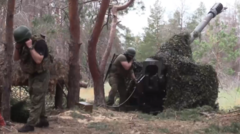In a bold escalation, Russia's military offensive in Ukraine has opened a third front, leading to unprecedented levels of drone and missile attacks on Ukrainian territory. Reports suggest that last month, Russian forces claimed territory gains of 556 square kilometers (or 215 square miles), a significant increase in their land grab efforts this year, according to the DeepState monitoring website. The gained area is comparable to four times the size of Liverpool or nearly identical to Chicago in size.
Russian military ambitions appear focused on severing supply routes for Ukrainian forces in the east while attempting to establish a buffer zone within Ukraine's northern borders. However, the pace of advance has proven frustratingly slow; estimates indicate a complete takeover of Ukraine could take over 70 years at current rates.
Key areas of Russian focus include the northeastern Sumy region along the border, the eastern cities of Pokrovsk and Kostyantynivka, and a newly established front west of Pokrovsk. Despite a brief advance of 10-12 kilometers (6-7.5 miles) into the Sumy region, Russian progress has since stalled due to stiff Ukrainian resistance. President Vladimir Putin's aspirations to fortify Russian territory come on the heels of Ukrainian troops' previous incursions into Kursk territory last summer, which ultimately brought about a Russian counter-offensive aided by North Korean support.
Currently, the Kharkiv region has reportedly seen Russian forces cross the state border; however, without substantial reinforcements, the likelihood of further gains remains grim. Military observers speculate that the Kremlin's strategy aims to stretch Ukrainian defenses across a 1,200-kilometer front line, diluting troop strength in pivotal areas like Pokrovsk, which serves as a critical military hub.
The Ukrainian military has noted a concentration of approximately 111,000 Russian troops in the Pokrovsk area, highlighting the intensity of the fight for dominance. Lt Artem Pribylnov, from Ukraine's 155th brigade stationed nearby, indicated that rather than launching large-scale assaults, Russian forces now employ small infantry groups to persistently engage Ukrainian defenses. This tactic, referred to by some as a "creeping offensive," seeks to exhaust Ukrainian defenses, although at a dire cost reflected in the staggering casualty rates, with Ukraine's general staff estimating upwards of 1,000 Russian soldiers lost daily.
Russia's strategic objective appears centered on encircling Ukrainian forces in an effort to compel them to retreat. Reports suggest that Russian troops are attempting to establish a foothold between Pokrovsk and Kostyantynivka to facilitate future attacks. However, the advances in this region are already experiencing significant slowdowns, and previous attempts to push from different angles have stagnated.
Recent Russian territorial gains in areas west of Pokrovsk, particularly around the Novopavlivske region, have raised alarms within Ukraine, with military bloggers claiming Russian troops made notable strides, supposedly even reaching the Dnipropetrovsk region. Ukrainian officials, however, refute these claims, asserting that a small cadre of Russian soldiers was forced to retreat shortly after capturing a village.
Despite increasing pressure, the capacity for Ukraine to resupply its frontline troops is becoming severely strained, as Russian drone attacks target critical supply lines. Staff Sgt Viktor Pyasetskyi mentioned that routes previously considered safe have become unviable for transportation, resulting in delays in delivering crucial supplies and evacuating wounded troops.
The ongoing drone offensive is not only aimed at dismantling Ukrainian defenses but also seeks to demoralize the civilian population, as reported by Staff Sgt Pyasetskyi, who recounted the destruction of civilian structures. Amid the chaos of war, Ukrainian resolve is tested as the roar of drones becomes a persistent reality, underscoring the grim landscape of an ongoing conflict that shows no signs of abating.


















